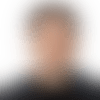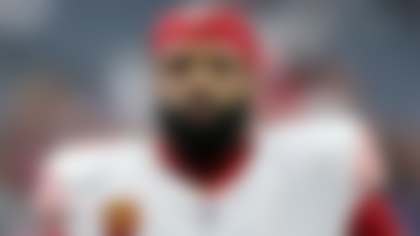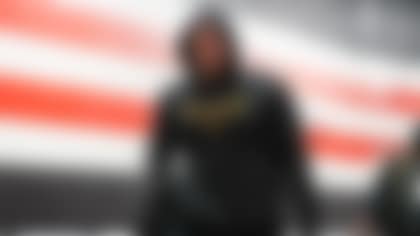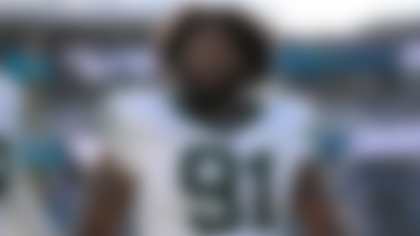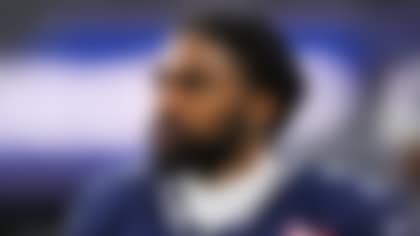NFL fans are familiar with "statement games." In 2013, Carolina Panthers general manager Dave Gettleman had a statement draft.
Selecting defensive tackles Star Lotulelei and Kawann Short with his first two picks was Gettleman's message and mission statement. The Panthers would become bigger and tougher under Gettleman. He said he desired "hog mollies," the kind of players that could push teams around, especially up front. The draft strategy is as blunt as Gettleman's Jersey-inflected manner of speech. Lotulelei has proven to be a key run stuffer. Short is a star. A few years later, the Panthers are serving "Hog Molly" sandwiches at home games.
Gettleman's fingerprints aren't only on the in-stadium dining. He's threaded the needle between cleaning up past mistakes, planning for the future, and attempting to win now since taking over for Marty Hurney as general manager in 2013. The Panthers have won the division title three straight times, in large part because of the cornerstones that Hurney acquired or hired: Cam Newton, Luke Kuechly, Ryan Kalil, Thomas Davis, Jonathan Stewart, Greg Olsen and Josh Norman, not to mention coach Ron Rivera and offensive coordinator Mike Shula.
Hurney deserves praise for acquiring so much top-shelf talent. And Panthers owner Jerry Richardson deserves the credit for pulling the plug on Hurney in 2012 because of bloated contracts, poor salary cap management, and an inability to sustain success. Gettleman, who cut his teeth with the Giants, has proven to be the right man to navigate out of cap trouble while picking up bargain role players in free agency along the way.
While most teams spend huge money in the secondary, Gettleman has essentially replaced the group every season with castoffs like Kurt Coleman, Roman Harper and mid-level draft picks. The defense hasn't suffered. Gettleman resisted the calls to sign a veteran stopgap at receiver when wide receiver Kelvin Benjamin, Gettleman's excellent 2014 first-round pick, tore his ACL in August. Gettleman believed the guys in place would suffice. The Panthers lead the league in scoring with Ted Ginn, Jerricho Cotchery, Devin Funchess and Corey Brown at wide receiver.
Hurney's core pieces form the foundation of this 17-1 Panthers squad built around Cam Newton. But Gettleman has feverishly filled in the cracks with players from outside the organization. Only two teams in the NFL (Chicago, New York) have more players than Carolina's 27 players acquired from another team.
This Panthers team is ahead of schedule. They weren't necessarily supposed to make the Divisional Round in 2013 or 2014. Even after that success, most preseason prognostications had them as a below-average team following Benjamin's injury. (Whoops.) Gettleman saw value where others did not, and now he oversees a team in great salary cap shape, positioned to take full advantage of Cam Newton's prime. This is only the beginning.
Here's a look at how the Panthers roster was built:
» Carolina's offensive line was expected to be a weakness entering the season. Instead it has been one of the best groups in the league, especially when Newton drops back to pass. Gettleman believes left tackle Michael Oher was the team's key offseason pickup in 2015, a move that was roundly criticized after Oher's struggles in Tennessee. Four of the Panthers' offensive linemen have been picked up in the last two years, all for cheap, including Pro Bowl guard Trai Turner in the third round of the 2014 draft.
» Gettleman isn't afraid to believe in players who were not well-loved elsewhere. Kurt Coleman went from a punchline in Philadelphia to a key contributor in Carolina. Ted Ginn was a bust as a top-10 pick in Miami and didn't last in San Francisco, but he was one of the most effective players in the NFC Championship Game for Carolina. Cortland Finnegan was out of the league until he was signed to play big playoff snaps following Charles Tillman's season-ending surgery.
» The roster's preference for size isn't limited to guys like Lotulelei and Short. Kelvin Benjamin and Devin Funchess will form a massive pair of receivers for Newton to target next season.
» The Panthers have five active players that have been with the team since 2009 or before. The Broncos don't have any. Jonathan Stewart and Thomas Davis have overcome an incredible amount of injuries to make it to this Super Bowl still with the organization. Ryan Kalil and Charles Johnson also both went through a lot of lean years with the team to emerge out the other side.
» One of Hurney's best moves, the 2011 trade for tight end Greg Olsen, was an incredible act of opportunism. The Bears were trading Olsen because their offensive coordinator Mike Martz had no use for pass-catching tight ends. Olsen only cost a third-round pick and was of interest because then-Panthers coordinator Rob Chudzinksi coached Olsen in college. Ron Rivera and Cam Newton have enjoyed the benefits years later.
Make sure to watch Super Bowl Opening Night live Monday on NFL Network at 8 p.m. ET.
